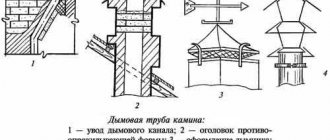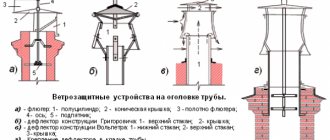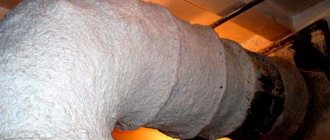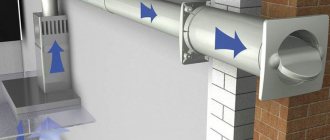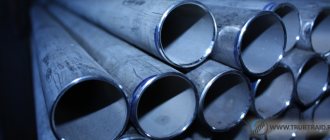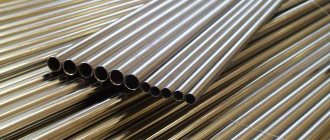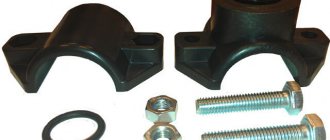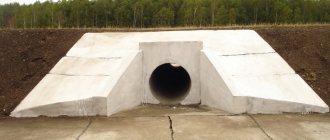Menu:
- The deflector is
- Installation of a classic device
- Installation of weather vane deflector
- Installing a ventilation deflector
- Useful tips
- Turbo deflector
- Advantages and disadvantages
- Installation
When solving problems related to smoke removal or creating ventilation circuits, you need to pay enough attention to creating a good level of draft.
To achieve the desired effect, install a deflector. In this material we will tell you about installing this part with your own hands, its properties and varieties.
Ventilation deflector: the best way to improve air circulation
In order for a person to be comfortable in a room, it is necessary to ensure normal air circulation. Continuous air exchange creates a properly organized ventilation system, but its effectiveness depends on internal draft. If the ventilation duct is not protected, there is a risk that the structure will become clogged with debris and stop functioning. To prevent problems, a ventilation deflector .
Deflectors help reduce the influence of weather influences on the ventilation system.
What does the deflector consist of and what tasks does it perform?
The effective operation of the ventilation system is primarily influenced by the strength of the wind, its direction, and air temperature. For example, in summer it is very hot outside, and due to the fact that the air heats up, draft decreases and, accordingly, air circulation decreases. To reduce the impact of such negative impacts, devices such as deflectors are installed. The use of structures is considered mandatory when organizing a chimney, because the deflector is, first of all, a device that normalizes the operation of the ventilation system.
A dome, ball or other structure that is installed on the roof and acts as a deflector.
On a note! To understand what a deflector is, you should refer to the images of ventilation pipe outlets.
It is the dome, ball or any other structure located on the roof that is the deflector. The main task of the device is to ensure normal ventilation of various types of premises by using wind loads. By and large, the deflector is a fairly simple device, which was previously used only when equipping chimneys, but is now the crown of the ventilation system. However, one should not think that the only role of the device is protective.
Chimney cap: how to choose a chimney cap for a chimney pipe (read more)
In essence, deflectors are aerodynamic devices that reduce the negative impact of weather factors on ventilation operation. Functioning occurs according to the principle of the Bernoulli effect. The main task of ventilation deflectors is to provide better draft within the system by regulating the air flow.
That is why the devices are installed at the highest point of the pipe. You can see the fixtures on most garages, which are topped with pipes coming out of basements or basements. In addition, deflectors are located almost everywhere on the roofs of houses.
The main task of deflectors is to provide better draft inside the ventilation system.
Installation of weather vane deflector
Installation of the sampling device with a windproof element is carried out according to a certain algorithm.
The operation is performed as follows:
- Inside the smoke exhaust channel, the upper and lower bearings are strengthened at two levels. In addition, you need to secure the vertical axis.
- The semi-cylindrical screen, roof and weather vane are placed on a vertical axis.
Remember that the bottom bearing acts as a stop for the axle. Be sure to securely fasten it inside the channel.
The operating principle of the deflector-vane is quite unique. After the wind direction changes, the weather vane begins to rotate. A curtain moves along with it, covering the channel from the influence of wind. Therefore, smoke begins to come out from the leeward side of the chimney.
Reception wind flows slide along a semi-cylindrical screen, increasing traction. In order for the wind vane to rotate easily together with the blade, the head bearings must be lubricated. During the cold season, it is also necessary to remove ice that arises from condensation.
This type of device is best used in regions with a mild climate and not too severe winters. Because servicing this device is quite difficult in very low temperatures.
Why install a deflector on a chimney, what are its main functions
As already noted, after installing the air duct deflector, draft increases significantly. This happens because the design deflects air flows and forms a low-pressure zone at the outlet of the ventilation. It is for this reason that the air masses inside rise through the pipe and compensate for the lack of pressure.
On trading platforms you can find a large number of design varieties, but despite this, they all work on a similar principle. Some manufacturers produce deflectors with narrowed channels to increase the speed of air passage over the pipe head. In this case, the “airbrush principle” comes into play, and the thrust becomes several times greater.
If you choose the right air deflector, you can significantly increase the efficiency of ventilation. Sometimes productivity increases by 20%. Devices installed on ventilation ducts that have a large number of horizontal and winding sections work best.
The main task performed by deflectors installed on the roof is to protect ventilation ducts from the penetration of contaminants, as well as birds and other living creatures from the outside. Even in a short time, small debris, fallen leaves, dust and other particles accumulate on the walls of the pipe, thereby leading to a narrowing of its diameter. For these reasons, the entire system may fail. Other instrument functions:
Chimney deflectors increase draft and perform a protective function.
- protection from precipitation;
- increased traction;
- increasing ventilation efficiency up to 20%;
- extinguishing sparks and ensuring fire safety;
- preventing the appearance of reverse draft, the so-called ventilation tipping effect.
The deflector is
The deflector is an important element of the chimney.
A device used to enhance draft in ventilation and gas exhaust ducts is called a deflector. It is also installed to protect the channel from penetration of moisture and debris.
We will analyze the installation features of these types of devices:
- classical;
- weather vane;
- deflector for ventilation.
Each model has certain features. Take them into account when attaching to the head of the smoke exhaust duct. The information will be useful for solving such problems as installing hoods on the roof (including pitched roofs) of boiler houses and other buildings. The roof can be soft, made of corrugated sheets and other building materials.
What is a ventilation diffuser
To better understand how ventilation system deflectors work, you need to know what the design consists of and what the device diagram looks like. So, the main components of the ventilation nozzle are:
- Diffuser. It is a cone-shaped base with a truncated bottom. The lower fragment of a cylindrical flask is attached to the upper part of the ventilation duct opening onto the roof, which results in a slowdown in air flow and an increase in pressure.
- Umbrella. A part that prevents debris from entering the ventilation duct. It looks like a protective cap attached to the top of the diffuser.
- Frame. A part of the deflector that is in plain sight. It is represented by a shell or rings, which are connected to the diffuser using two or three brackets. It is precisely because the housing elements cut through the air flow that a reduced pressure is formed inside the cylindrical flask.
To prevent precipitation from penetrating into the system, the diameter of the diffuser must exceed the size of the inlet. The housing is installed in such a way that air creates a so-called suction through the recesses of adjacent rings. In this case, it will be possible to speed up the removal of air masses from the ventilation system.
To prevent precipitation from entering the system, a protective umbrella is installed.
On a note! The ventilation deflector is designed in such a way that air flows that rise from bottom to top are reflected from the roof, and then begin to fall again. Most often this happens when the wind blows from below. If such a problem exists, it is better to install a double-cone structure, where the elements are connected by one base.
You also need to understand that if there is a side wind outside, the air flow will begin to exit through the lower and upper parts. When the wind direction is vertical, there will be only an outflow of air from below.
In short, the principle of operation of the deflector installed on the hood looks like this:
- wind flows are captured by the device;
- the air flow enters the diffuser, branches out and leads to a decrease in pressure in the upper part of the channel;
- the exhaust air from the room rushes upward - to where the rarefied void has formed - and is discharged outside.
If you choose the correct size of the deflector and correctly install the structure on the upper part of the exhaust duct, the pressure difference will be optimal, as a result of which the intensity of air exchange will be normalized.
Thanks to the diffuser, the air flow slows down and the pressure increases.
Installation
To install a rotary turbine there is no need to have any serious knowledge or skills. The product is small in size and weight. Its installation can be carried out by just one person. On average, it will take you two hours to install a turbo deflector. The product is installed at the highest point of the roof and along the ridge. The distance to other deflectors must be at least four meters.
To prevent snow from getting inside, the product must be mounted at a sufficient height. In the air ducts themselves, it is permissible to use valves to regulate ventilation processes.
Remember that the temperature level inside the channel should not exceed one hundred degrees. To remove high-temperature gases, you need to use special nozzles.
An example of installing a deflector on a part of a vent. channels with transition
It is possible to create rotary turbines with your own hands. For this you need a drawing of the device. To create a device you do not need to have serious skills and knowledge. The device can also be purchased. There are a lot of companies on the market offering their products. Study the market in detail before buying. Remember that every manufacturer claims that their products are the best. This is not always the case.
Video
Types and characteristics of pipe deflectors: main differences
If you look at the photos of deflectors, you will notice that they all look different, but nevertheless perform the same functions. Therefore, before giving preference to one of the models, you should pay attention to the following criteria:
- material of manufacture;
- operating principle;
- design features.
Basically, all models are made from the following materials:
- aluminum;
- of stainless steel;
- galvanizing;
- copper;
- plastic;
- ceramics.
Note! Ventilation specialists believe that deflectors made of steel or aluminum are optimal in terms of price/quality ratio. Copper devices are also good, but due to their high cost they are rarely used.
The deflector can be made of aluminum, stainless steel, galvanized, copper and plastic.
Devices are divided into the following types:
- TsAGI, characterized by the presence of a ventacal expansion - diffuser;
- Volper cylindrical ventilation fungus;
- cap-weathervane, in common parlance - “sycophant”;
- H-shaped deflector made of pipes;
- turboreflector, which is a spherical rotary nozzle;
- static-dynamic device of open type Astato.
Some include in this list regular umbrellas installed at the top of the channel. It should be understood that this kind of device only helps to protect the ventilation from rain, but does not in any way affect the draft.
Open structures also differ in shape; the following devices are considered the main ones:
- flat;
- semicircular;
- with opening lid;
- gable.
In addition to the fact that devices are divided according to the type of weather vane, they are also classified according to the principle of operation:
- rotary;
- deflector;
- turbine
The operating principle of the device can be rotary, deflector or turbine.
Chimney deflectors are primarily installed to improve draft, which removes smoke and carbon monoxide outside. In addition, after installing the device, heat transfer increases, and the fuel burns better. Various photos of chimney deflectors also make it clear that with the help of the device the pipe is protected from precipitation and other debris brought from the outside.
Air conditioner deflectors, which differ in appearance from conventional devices, can be classified as a separate group. This design is a reflective screen that redistributes the air flow. Thanks to this, the beam of cool air is not directed directly, but parallel to the ceiling. Even though the air is dispersed, the pressure does not change.
Which design should you choose?
When choosing a specific model, primary attention is paid to its design. This is one of the key parameters of the product. Having decided on the design type of the device, the optimal size of the unit for a particular case is selected. It is easier to choose the right device if you answer a simple question - why is the structure being installed and for what object.
Best models:
- ASTATO;
- rotary;
- TsAGI deflector of disc type.
When choosing, take into account the coefficient of losses and air vacuum. It follows that these values depend on the specific model. If we are talking about DS type solutions, the corresponding coefficient will be 1.4. Obviously, the degree of air rarefaction depends on the wind speed.
| Wind speed | 0,005 | 0,007 | 0,01 |
| Vacuum level | 11 | 21,6 | 44,1 |
The material of manufacture should also be taken into account when choosing a product. Hood heads are made from galvanized steel, plastic, stainless steel, aluminum and even copper.
From the point of view of practicality and optimal price/quality ratio, it is wise to choose products made of galvanized or aluminum. Copper models are rare in real life because their cost is very high. Pure plastic is not very common due to its fragility; as a rule, the base deflector is made from this material.
Models made of metal with a plastic coating or its equivalent for the basement ventilation system have good strength characteristics and decorative appeal.
TsAGI deflector and other design options
The basement deflector is primarily intended for ventilation of basements and lower floors. After installation, not only fresh air circulation is established, but also excess moisture evaporates from surfaces. It is considered convenient that the devices can be installed in the case of both forced and natural ventilation.
In addition, the advantage of the deflector is that it protects the basement floors and basements from the penetration of rodents and other small pests, as well as from precipitation. When installing, it is better to take a pipe with a reserve length, because it can always be reduced to the desired height, but it will not be possible to increase it.
The TsAGI deflector consists of a glass, a cylindrical body, an umbrella-shaped cover and mounting posts.
The TsAGI design was developed back in the days of the Soviet Union and is still in use today.
If you look at the drawing of the TsAGI deflector, you can see that it consists of the following elements:
- a glass located at the bottom of the structure with an extension at the end;
- cylindrical body, represented by a steel shell;
- umbrella-shaped cover;
- mounting posts made of metal strips.
The principle of operation is as follows: due to the blowing of the housing, a rarefied zone is created located above the open diffuser. Exhaust air, mixed with carbon monoxide and other components, rises through the air duct into the area of the formed low pressure zone and goes outside. Here it is picked up by the wind and completely removed.
Note! The performance of a roof vent depends on the resistance of the duct system crossing the roof. The actual volume of the device is determined by the height of the pipe removal. The indicator is also affected by the temperature difference between indoor and outdoor air.
The designs of deflectors also differ in shape: flat, semicircular, with a lid and gable.
Despite the fact that the TsAGI device was developed a long time ago, it is still considered the best ventilation deflector for increasing thrust.
The high rating of the device is due to a large number of advantages:
- providing maximum protection against penetration of precipitation;
- preventing draft tipping, that is, drawing exhaust air back into the system;
- lack of dynamic details;
- reliability;
- minimum resistance coefficient, which does not exceed 0.6.
Among the advantages, the fact that it is quite easy to make a TsAGI deflector with your own hands also stands out. And most importantly, the productivity of the installation is not affected at all by wind flows, although it should be noted that the device does not work effectively at low wind speeds. So, if the external air flow moves at a speed of less than 2 m/s, the effectiveness of the deflector tends to zero. To be fair, it should be noted that in calm conditions most of these devices do not work well.
Over time, the design of the device was improved, because in the manufacture of the latest production models, insulation of the lower glass was used (in cases where the cap was mounted to a sandwich pipe on the roof).
A correctly selected deflector size will provide an optimal pressure difference.
Other options for ventilation deflectors series 5.904 51
The Wolper Static Umbrella is more of a windbreaker than a traction enhancer. Despite this, the nozzle successfully compensates for the loss of pressure at the flow outlet. According to the drawings, the structures consist of the following elements:
- lower glass or pipe;
- a cylindrical upper glass with concave walls;
- umbrella in the form of a cone;
- connecting strips.
The nozzle is mounted on an air duct having a circular cross-section, and in the case of a rectangular shaft, a special adapter is used. The principle of operation of the Volper umbrella:
- Direct wind flows are reflected up and down due to the concave surface of the upper shell.
- The air masses that pass between the umbrella and the cut plane of the glass form a low-pressure area inside the nozzle.
- The air from the hood changes the direction of movement, that is, it exits through the gap located under the “fungus”.
In terms of efficiency, the Volper umbrella is significantly inferior to the TsAGI deflector, but at the same time it more reliably protects the air duct from sudden gusts of wind. Because it is technically difficult to make an exhaust hood with a curved glass with your own hands, many simplify the design and give it a cone shape. To increase productivity, install a similar glass in mirror image, which is placed under the umbrella.
The Wolper umbrella successfully compensates for the loss of pressure at the flow outlet.
The H-shaped deflector is presented in the form of a pipe assembly and has the shape of the letter “H”. In this case, the hood is connected to the middle part of the crossbar. After installing such a structure, it becomes unimportant from which direction the wind blows into the open pipe, because the flow in any case will eject, or, more simply, carry along the flow of polluted air from the ventilation riser.
Among the advantages of the H-shaped ventilation pipe deflector are:
- almost 100% protection from wind;
- prevention of backdraft effect;
- no possibility of moisture penetration or freezing of the system.
In addition to the advantages, there are also disadvantages to installing a nozzle:
- Violation of aerodynamics. To exit to the street, the exhaust air flow needs to overcome 2 turns located at an angle of 90 degrees. Despite the fact that the wind flow compensates for this deficiency, the traction force still increases minimally, which is why the performance of the hood decreases.
- Large design size. Due to the fact that the device is quite bulky, difficulties may arise during the installation process.
- Not very attractive appearance. The volumetric structure placed on the roof is characterized by the presence of 2-3 channels, which are crowned with similar caps, which may look strange from afar.
The main advantage of the H-shaped deflector is 100% protection from wind.
On a note! To assemble a ventilation deflector with your own hands, you will need to take several ready-made tees and connect them together.
Such a device is suitable for ventilation of both a bathhouse and a warm barn.
How is it arranged?
The design of the deflector is quite standard; each of its varieties consists of the following elements: special glasses, clamps for holding it on the roof surface, and a pipe. In this case, the lower glass-cylinder has an even structure, and the outer one is expanded towards the bottom. They are put on top of each other, and a lid is installed on top. The upper part of each cylinder ends with bumpers in the form of rings that help change the direction of air flow.
The installation of the exhaust is carried out in such a way that external air flows carry out suction through the free space between the rings and speed up the removal of waste from the ventilation.
What are turbo deflectors and weather vanes?
The designs can be safely combined into one group, because they are not only similar to each other, but also have a similar operating principle. If we look at the drawings of turbo deflectors, we can pay attention to the fact that a distinctive feature of the devices is the spherical shape of the rotary devices with blades in the form of semicircles that rotate under the influence of wind force. In this case, rarefied air, which increases the efficiency of the hood, is formed inside the sphere above the head of the pipe.
The productivity of the weather vane is ensured by the fact that the blades of the device always turn their backs to the wind, thereby preventing air flows from entering the channel. A low-pressure zone, the so-called aerodynamic shadow, is formed behind the structure’s body, facilitating the rapid removal of polluted air from the vertical channel.
Among the advantages of the ventilation turbo deflector are:
- protection of the ventilation duct from overheating in the summer, which reduces the cost of cooling the room on hot days;
- preventing the formation of condensation under the roof by regulating the temperature in hot weather;
- no need to connect the device to the electrical network;
- ensuring efficient operation, because the productivity of the turboreflector is in some cases 200% higher than that of static models.
The main advantage of the turbo deflector is that there is no need to connect the device to the electrical network.
In addition, we can separately note the fact that the nozzle has an attractive appearance. Unlike other models, the device looks like an elegant spherical cap. After installing the deflector, excess heat, moisture, minor contaminants and carbon monoxide vapor are independently drawn out of the shaft and under-roof space. This increases the service life of important structural elements of the building.
Before purchasing a ventilation turbo deflector, you should familiarize yourself with the main negative aspects of the device:
- if there is no wind outside, the blades of the structure will not rotate and, accordingly, traction will not improve;
- the deflector rotation units require constant maintenance, at least regular lubrication;
- if you do not notice in time, complete or partial freezing of the nozzle is possible;
- design features do not allow the device to reliably protect ventilation from precipitation, especially on windy days;
- in strong winds, there is a possibility that a jammed weather vane will lose its integrity.
Relative disadvantages include the fact that the price of dynamic type deflectors is higher than the cost of static models. For example, the cost of umbrellas and deflectors for ventilation systems 5.904 51 does not exceed $20-30, while turbo-reflectors can be purchased for at least $35-40, and the equipment requires constant maintenance.
The productivity of the weather vane is ensured by the blades, which always turn the device “back” to the wind.
Material for production
Ventilation hoods differ not only in appearance, but also in the material from which they are made:
- Made from plastic, such devices are quite fragile and therefore are rarely found on store shelves;
- Made from metal coated with plastic, such models are more durable and have a rather attractive appearance;
- Made from metal intended for the manufacture of boilers, such devices are expensive, but are highly resistant to burnout from exposure to hot air flows;
- Made from galvanized steel, products made from this metal are considered the most common because they have an affordable price and at the same time have good strength;
- Aluminum, also popular among manufacturers, has good strength and an affordable price.
There are also caps made of copper, but they are too expensive and therefore this metal is practically not used for the manufacture of deflectors.
What is the Astato roof ventilation deflector?
An important advantage of the deflector is productive operation in any weather, even when there is a complete absence of wind. If you study the drawings of the deflector, you will notice that the design is a nozzle made of two truncated cones, which are turned with their tops towards each other. On the top of the device there is an umbrella and an axial electric fan. The side opening is protected from birds and other animals by aluminum mesh.
Among the operating features of the device, the following points stand out:
- In strong winds, the nozzle acts as a static amplifier. Even if the fan is turned off, the exhaust air flow passing between the mirrored cones is picked up by street air masses and removed.
- In calm or low-wind weather, a pressure sensor, the so-called pressure switch, is automatically activated, which transmits a signal to the EOL control unit. After this, the controller activates the fan, and forced removal of contaminated air from the shaft begins.
On a note! The controller response threshold is determined and adjusted by the user independently. A universal static-dynamic deflector can operate without expensive automation, because the function of switching on manually or from a temperature relay is available.
The Astato roof ventilation deflector is one of the most expensive devices of this type.
A significant disadvantage is the high price of the ventilation deflector: even a nozzle with a minimum diameter of 16 cm will cost the user 1300-1400 euros. If you want the device to respond automatically to changes in ambient air, you need to add to this price the cost of the EOL unit, which is 1520 euros.
Features of selection
The design of the caps is not complicated, but despite this, buyers should pay attention to the following points:
- the material from which the deflector is made;
- How does it work;
- take into account all the features of the device.
The choice is also made taking into account:
- if there is little or no draft, you should choose rotary or weather vane nozzles;
- when purchasing a rotating attachment, you should know that inexpensive devices work using an open bushing, which freezes in winter; it is recommended to pay attention to those that have a closed hinge;
- caps in the shape of the letter H are perfect for areas where there are strong winds.
Dynamic hoods are suitable for all types of terrain, but they must be serviced periodically.
Installation
The installation process is simple, but it should be remembered that not all actions are carried out directly on the roof, since the cap and the base of the device should be connected in advance, for convenience. So, the installation consists of:
- from installing the device on the inlet duct and securing it to it, this is done with special fasteners or bolts. In the second case, you will need to drill inlet holes for them;
- securing the diffuser funnel with clamps or brackets;
- placing the cap on the diffuser.
The last two steps are carried out before installing the device on the ventilation duct.
Experts in the field of installation of such structures recommend following some tips:
- The device is installed both on straight and pitched roof surfaces, chimneys and ventilation. The choice of location depends directly on the purpose for which it will be used.
- If the surface is sloping, then it is necessary to install it at the highest point; on a flat surface, before installation, the possible height of the snow cover is taken into account and placed higher. It is recommended to set the level to at least 18 cm.
- To avoid heat loss during the cold period, it is possible to install special dampers for residential premises and adjustable air intakes for non-residential premises.
When installing the device on a chimney, remember that it automatically extends its height.
How to choose a ventilation deflector: what to look for
If you need to select a traction amplifier at minimal financial costs and not think about additional maintenance, you should opt for static deflectors: this could be a Volper cap or a TsAGI nozzle. The main advantage of the second option is that it is quite simple to construct such a deflector with your own hands.
Basic recommendations for choosing a forced draft device:
- If there is a lack of traction, it is better to choose dynamic models of caps - this could be a rotary deflector or a weather vane.
- When purchasing a rotating design with blades, you should not save money. Cheap models often have an installed open hinge, which will freeze in winter. When choosing a turbo deflector or weather vane, you need to ensure that the bearing is closed.
- If you plan to install the amplifier in an area with predominantly windy weather, an H-shaped nozzle is recommended. If, on the contrary, the weather is often windless, the TsAGI deflector is the option of choice.
- The Astato nozzle, although it works in any weather, requires regular maintenance. And this despite the fact that the cost of the structure is very high.
If there is a lack of traction, it is better to give preference to dynamic models of deflectors.
Features of device installation and useful tips for proper installation
To correctly calculate the deflector, you need to measure the diameter of the exhaust shaft. If there is a rectangular exhaust shaft, you should select a device with a round cross-section, the value of which is equivalent to the size of the channel. That is, you need to calculate the cross section of the rectangle and take a circle with a similar area. It is also necessary to remember that in this case, an additional adapter will be required for installation.
As for the installation of the deflector, they are guided by SNIP standards governing installation rules.
So, first of all, you need to pay attention to the height of the ventilation pipe and hood, which is determined depending on the location on the roof:
- The height is 50 cm, if the air duct is located closer than 1.5 meters from the edge of the roof.
- At the same level as the ridge or slightly higher, when the distance from the parapet to the ventilation shaft varies from 1.5 to 3 meters.
- If the pipe is more than 3 meters away, the height is selected so that the top of the deflector is not below the deviation line drawn from the ridge down to the edge of the roof at an angle of 10°.
Note! If the building has a flat roof, the device is installed at a height of at least 50 cm.
It is optimal when the deflector is installed at the stage of roof installation.
Additional points to consider during installation:
- The deflector cannot be mounted in an area covered by the aerodynamic shadow of other buildings.
- The device must be mounted where there is free airflow. It is best when the cap is the highest point of the roof.
When organizing a ventilation system, you should also not forget how to install the ventilation grill correctly - up or down. Most craftsmen focus on the fact that if there is forced ventilation, air will somehow get into the shaft, so when installing it is better to focus on how the wall will look after installation and whether the grate gaps will be noticeable.
dimensions
Having selected the device according to the type of material and design features, you should calculate the dimensions of the deflector that will suit you. The table below shows the main ones using the TsAGI nozzle as an example.
Standard sizes of TsAGI nozzle
If there is no value above that corresponds to the parameters (diameter) of your ventilation duct, the deflector is calculated according to the following principle:
- Diffuser width = 2*channel diameter;
- Umbrella size (width) = 1.8*channel diameter;
- Total height of the device = 1.7 * channel diameter.
You can use the following scheme to calculate all elements depending on the selected pipe diameter:
Drawing of a deflector with calculations of element values
How to make TsAGI and a turbo deflector for ventilation with your own hands: drawings, stages of work
The turbo deflector has a rather complex design, so not many people undertake the manufacture of the device themselves.
If you decide to make just such a design, you need to ensure that you have the following tools and materials:
- sheet of stainless or galvanized steel;
- electric or cordless drill;
- regular and metal scissors;
- bolts, screws, nuts and clamps;
- items for drawing up a drawing: ruler, pencil, compass, cardboard and graph paper;
- welding machine.
When making a TsAGI deflector yourself, you will need: a mallet, a drill, a vice and metal scissors.
When making it yourself, it is important to correctly make the landing part, which will correspond to the required pipe diameter. After this, plates with a tube located in the middle, into which the dynamic part of the device is inserted, are welded to the finished part. Then steel blades are formed using the finished template, which are attached to the structure and form a turbo deflector. To understand how the execution process goes, it is better to refer to the videos available on the Internet.
Most craftsmen prefer to make a TsAGI device at home, because making a deflector is quite simple. To do this, you will need to take galvanized steel no thinner than 0.5 mm, from which the necessary parts are then cut out. Rivets, bolts and nuts are used to assemble the structure. To work you will need the following tools:
- hammer or mallet;
- drill;
- vice;
- metal scissors;
- tape measure and pencil.
After cutting out the necessary parts from sheets of tin, they are connected to each other using rivets.
Due to the fact that a large number of ready-made drawings are available on the Internet, it will not be difficult for anyone to draw a diffuser. The main thing is to determine the size correctly. The most popular parameters are ventilation ducts with a diameter of 10-11 cm, especially if the hood is made of a plastic pipe.
So, after the necessary parts are cut out of sheets of tin, they are connected to each other using rivets. Then the finished deflector is put on the head, and the lower pipe is tightened using a clamp. If the shaft is square, an adapter is additionally made or purchased, the flange of which is attached to the end of the pipe.
Properly designed ventilation will help maintain a normal microclimate in your home, and a deflector installed on the roof will provide draft that will quickly clear the room of exhaust air. Despite the fact that most appliance models are not very expensive, they still guarantee productive hood and preserve the health of residents.
